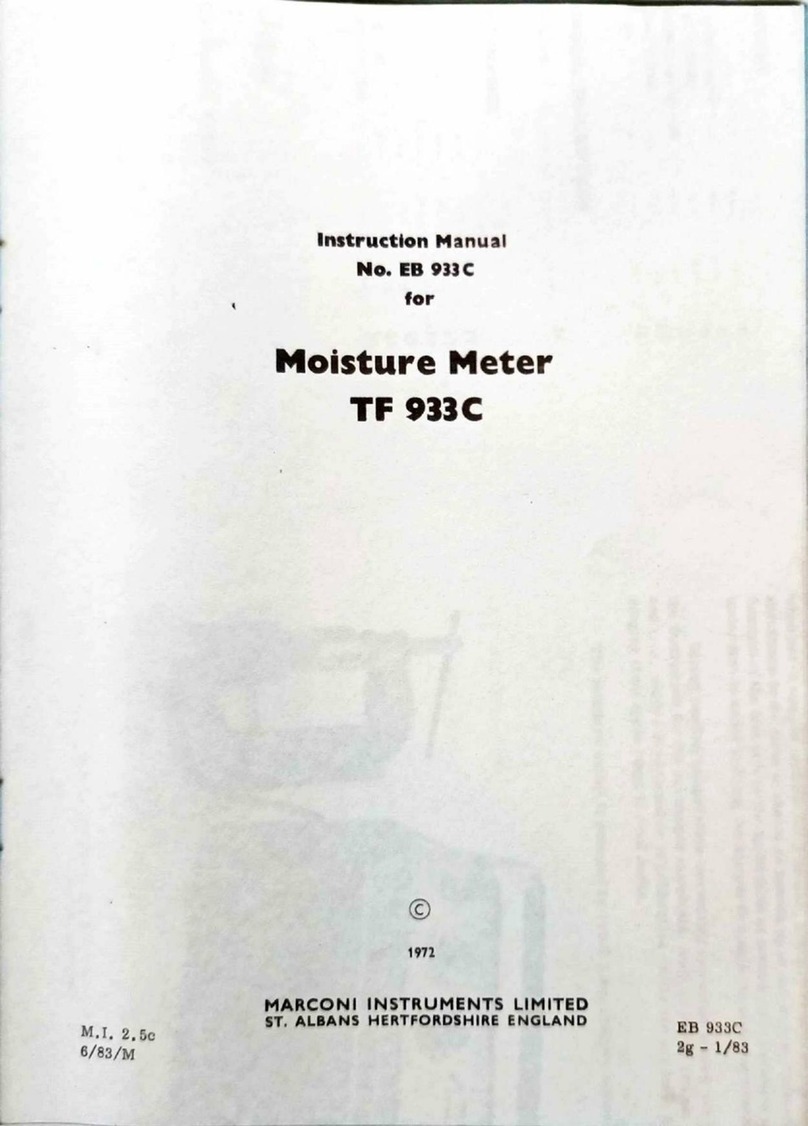
ARY
IIANGF,:
ACCURACY:
SF.LF-CIIECK FACILITY:
CALIBRATION:
SCALES:
Cereal grains and
agriculturalseeds:
Flour and wheat:
Cigarettetobacco:
4
Paper: 4 to 13%for paper; 6 to 22%
for chemic
pulp and boards. Temperature 10to 3:
Moisture contents from belowair-dry to near
saturation.
The basic accuracy of the instrument is
TO.
5%
m.c. , but variations due to the nature
of the samples may reduce this to m. c.
The accuracy tends to fall at highmoisture
contents.
The instrument may be checkedagainst the
internal standard resistance of 1 MS)
at a
meter reading of 40.
The calibrations, which are made by comparison
withstandard analytical procedures, are based
on ground samples wherever possible.
'the standard apparatus includesany one ofthe
direct readingscales listed below,as ordered.
9 to 25%for wheat, rye and maize; 8 to 2'1%
for barloy and oats. Temperature -1 to 38oc
(30 to 100
0F). The scales are based on oven
drying for four hours at 120oc (248OF).
Tables are providedcoveringagricultural seeds.
9 to 25%for groundwheat; 10to 20%
for flour.
Temperature -1 to 38oc (30to 100OF); outside
the range 10 to 30 oc (50 to 86 01•)
there may be
a slight fall in accuracy. The scales are based
on oven drying for four hours at 120oc (248OF).
Tables givenfor other mill stocks and
products.
Sto 20%
for 'cigarette ragt (equivalent
to cut
wholeleat) and 9 to 21%
for cut lamina. Tent-
perature 10 to 30 oc (50 to S6OF). The seaI""
are based on oven drying for sixteen hours at
100Oc (212 OF).
93.31',
Tick beans:
Rice:
POWER SUPPLY:
DIMENSIONS:
WEIGHT:
1.3 ACCESSORIES
Accessories supplied
to 90 OF). Supplementary information
provided covering manytypes of wood
p
paper andboards. The scales are basc
oven drying to constant weightat 102to
(215.5 to 221OF).
9 to 22.5%
for groundbeans. Tempera
10 to 30 O
c (50 to 86 OF). The scale iE
on oven drying for fifteen hours at 105c
(221 O
F).
10
to 22%
for polishedrice. Temperat
to 30 O
c (50to 86 OF). The scale is ba
ovendrying for fifteen hours at 105oc (
Internal batteries: one 67.5 V and two
Height
7 3/4 in
(1970 mm)
Width
11 3/8 in
(2880 mm)
Depth
5 1/4 in
(1350 mm
8 1b
(3.65 kg) withcompression cell ele
andbatteries.
1.
2.
3.
4.
5.
Compression Cell Electrode Assembly type TM4113A
(complete with Cla
Tc 22429, Electrode TM4178A, RingTB 22425/2, Plunger TB 22425/1a
3 ft ConnectingCableTM4130A).
Oneset of CalibrationData, TM4473Aseries, as ordered see under
Accessories available. Aset of calibration data comprises a slip-on
calculator scale anda booklet, card or sheet givingsupplementaryinforn
onsubstances covered by the calculator scale andin some cases, allied
One67.5 Vbattery; Exidetype DM5()1or Ever ReadytypeBIOI, VidorI
or equivalent.
Two 1.5 Vcells; Exide type T21 or Ever Readytype LPU2, Vidor LPV2
equivalent.
One4 BAhexagonalwrench, type 22951-006; for carrying out the Ste
dizationtest detailed in Sect. 4.2.
OneInstruction ManualNo. EB 933B.
933B(1)




























